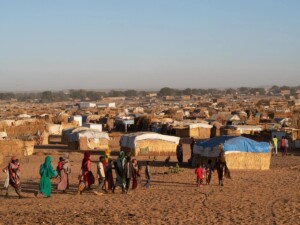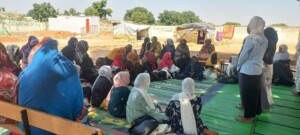Unicef reaches previously inaccessible areas in Blue Nile, Central, and South Darfur
The United Nations Children’s Fund (Unicef) has been granted access to a few hard-to-reach areas such as Kurmuk (Blue Nile State), Golo (Central Darfur) and Belle El Serief (South Darfur), the latter had not been accessible for over five years.
The United Nations Children’s Fund (Unicef) has been granted access to a few hard-to-reach areas such as Kurmuk (Blue Nile State), Golo (Central Darfur) and Belle El Serief (South Darfur), the latter had not been accessible for over five years.
The UN Office for the Coordination of Humanitarian Affairs (OCHA) in Sudan reports in its latest humanitarian bulletin that Unicef has begun working with government authorities, state officials and partners to bring long overdue assistance, including child protection, education, health, nutrition, water and sanitation services to the vulnerable communities in the newly reached areas.
Kurmuk, Dindero, Jort and Bolang receive water and education assistance
In Blue Nile State, Unicef, through the State Ministry of Health (SMoH) managed to assign additional staff to Kurmuk hospital and provided health centres with medical supplies enough for two-months. In addition to two mobile clinics that serve about 15 villages Unicef—in coordination with SMoH—plans to train 100 healthcare providers and community health workers, including midwives. Through Unicef support, the SMoH conducted training for 16 nutrition care providers and established four supplementary feeding programmes.
Aid organisations—with Unicef support—distributed chlorine tablets in Dindiro town for household water treatment, and installed two water bladders (with a capacity of 10,000 litres each). This is in addition to 260 barrels of water to that are trucked in daily, benefitting 10,000 people in the town. In Dindiro, Kurmuk town, Jurut East, Jurut West and Bulang, Unicef, IRW and WES have started rehabilitating 20 hand pumps. Unicef is also assisting in the rehabilitation and construction of 10 schools in these areas and will provide school supplies, benefitting 2,855 children.
There were also 105 separated and unaccompanied children in Bulang, Dindiro, Jurut East, Jurut West and Kurmuk town who received assistance. The children were placed with families—who were trained on alternative care measures and psychosocial support—and were provided with plastic sheets and sitting mats. The children were also provided with birth registration services and medical insurance.
Health, education and water services in Golo, Central Darfur
In Central Darfur, Unicef has supported the SMoH in establishing a cold chain in Golo hospital and has provided the necessary vaccines, while routine vaccination has begun at the hospital. Health kits and essential medicines have also been provided to the Golo hospital through SMoH. For education, Unicef and the State Ministry of Education (SoME) have begun providing classroom seating, recreation kits and School in a Box kits benefitting 3,000 students in five schools in Golo. For water assistance, Unicef supported the Government’s Water and Environmental Sanitation Department (WES) in Golo, to drill six hand pumps and build one mini water yard. Unicef has also provided enough chlorine to treat all water sources in Golo. Regarding Nutrition, Unicef supported IMC, CRS and SMOH in establishing 6 Nutrition feeding centers (OTPs) with 700 cartons of Plumpy Nuts (UTF) provided. Furthermore, 8 Nutrition cadres were trained to operate the inpatient feeding center inside the hospital. For Health, 15 community health workers (CHWs) from Golo locality, were trained on Integrated Community Case Management (ICCM).
People in Belle El Serif, South Darfur receive water and sanitation assistance
In Belle El Serif village, South Darfur, Unicef and the international NGO Oxfam America, are sensitising the community on proper hygiene practices. In addition, 905 household latrines were built for 5,500 people. Furthermore, Unicef has supported the construction of one dam and one well in Deribat town, benefitting 15,000 people from the town and surrounding villages. Three hand pumps were rehabilitated in Belle El Sereif, supporting 1,500 people. Humanitarians estimate that about 46 per cent of the population in Belle El Sereif are children. Unicef coordinated the efforts and led the assessment, the above mentioned activities achieved in Belle El Serif, are done by Unicef partner Oxfam America.
Japanese Government support
In a media statement from Khartoum today, Unicef says: “The Government of Japan has responded to the urgent humanitarian call to address the growing children’s emergency in Sudan with a US$955,000 grant to Unicef. The grant is a part of the overall support to address the basic humanitarian needs of children and their caregivers in South and West Kordofan, with a focus on health, education, nutrition and the integration of water and sanitation hygiene.
“I am pleased to announce the commencement of this project that particularly targets vulnerable IDPs, refugees and host communities in South Kordofan State and West Kordofan State which are affected by the protracted regional conflict and the influx of South Sudanese Refugees. I hope our contribution enables Unicef to address the challenges faced by vulnerable people, in particular children and women, affected by emergencies in the targeted areas” said His Excellency Hideki Ito, the Japanese Ambassador to Sudan.
Health centres
The funds will enable some 95,000 children under 2 years to be vaccinated against measles and polio diseases, 70,000 pregnant women to be attended by skilled birth personnel, while 60,000 infants will be provided with essential new born care. The funds will also support the training of 250 health staff on skilled birth attendance and new born care, as well as Community-based Management of Acute Malnutrition (CMAM) and Integrated Management of Childhood Illnesses (IMCI) protocols for communities and health facilities. In addition, 3 gender and disability-sensitive health and nutrition centers will have access to drinking water resources, improved sanitation facilities with hygiene promotion interventions.
Some 10,000 children from IDP, refugee, and host communities, will have access to child-friendly education services, and an additional 3,700 children and adolescents will have access to extra-curricular activities including life skills to prevent and deal with health consequences of violence, abuse and exploitation. Furthermore, this support will help provide access to education through the construction and rehabilitation of classrooms, provision of teaching and learning materials for over 10,000 vulnerable and conflict-affected school age children.
Investment in Sudan’s children
Unicef Representative Abdullah Fadil, expressed gratitude to the Government and people of Japan for the sustained and continued support to the well-being of the children in Sudan. “Unicef values the partnership with the Government of Japan and the sustained support to children in need, especially within a protracted context such as Sudan. Continued investment in Sudan’s children, especially the most vulnerable is a key building for the future stability of this country” Abdullah Fadil emphasized.
Over the last two years (2015 & 2016), with over USD $11 million continuous support from the Government of Japan, Unicef has achieved many of its programme goals specifically in the Health and
Education sectors. More than 217,000 pregnant women benefited from the social mobilization of local communities on maternal and newborn health issues, supportive supervision, and essential reproductive health supplies. More than 184,000 deliveries were assisted by skilled birth attendants in 39 localities. Additionally, 30,000 school children (50% girls) benefited from the procurement and distribution of 500 school-in-a-box sets containing teaching-learning materials. Some 15,423 previously out-of-school children (47.6% girls) were enrolled and are now learning in basic and ALP (Alternative Learning Programme) classes as a result of the social mobilization ‘back to school’ campaigns. 4,890 (50% girls) benefited from improved school environments through rehabilitation of 43 school units and the construction of 22 new school units.











 and then
and then